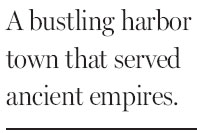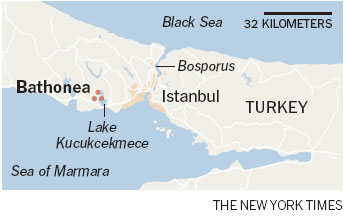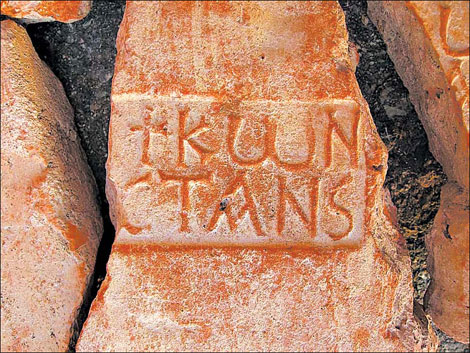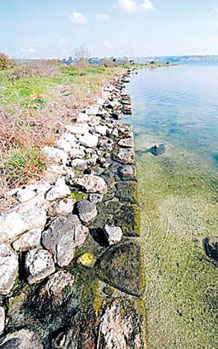A drought in Turkey uncovers antiquities
Updated: 2012-02-05 08:02
By Jennifer Pinkowski (The New York Times)
|
|||||||||||
|
Hundreds of bricks stamped "Konstans" were made there, starting in the fifth century. Photographs by Haldun Aydingun |
ISTANBUL - For 1,600 years, this city has been built and destroyed, erected and erased, as layer upon layer of life has thrived on its seven hills. Today, Istanbul is a city of 13 million, spread far beyond those hills. And on a long-farmed peninsula jutting into Lake Kucukcekmece, 20 kilometers west of the city center, archaeologists have made an extraordinary find. It is Bathonea, a substantial harbor town dating from the second century B.C.
Discovered in 2007 after a drought lowered the lake's water table, it has been yielding a trove of relics from the fourth to the sixth centuries A.D., a period that parallels Istanbul's founding and its rise as Constantinople, a seat of power for two successive empires - the Ottoman and Eastern Roman.
|
A 4-kilometer-long sea wall along Lake Kucukcekmece indicates a wider urbanized area for Constantinople. |
While there are historical records of this period, few physical artifacts exist. The slim offerings in the Istanbul section of the Archaeological Museums here reflect that, paling in comparison with the riches on display from Anatolia, Mesopotamia and Lebanon. So Bathonea has the potential to become a "library of Constantinople," says Sengul Aydingun, the archaeologist who made the initial discovery.
After the drought exposed parts of a well-preserved sea wall nearly four kilometers long, Dr. Aydingun and her team soon saw that the harbor had been equipped with docks, buildings and a jetty, probably dating to the fourth century. Other discoveries rapidly followed. And in the last dig season alone, the archaeologists uncovered port walls, elaborate buildings, an enormous cistern, a Byzantine church and stone roads spanning more than 1,000 years of occupation.
"The fieldwork Sengul has conducted over the last few years is spectacular," said Volker Heyd, an archaeologist at the University of Bristol in England who surveyed Bathonea for two field seasons.
"The discoveries made are now shedding a completely new light to the wider urbanized area of Constantinopolis. A fantastic story begins to unveil."
Dr. Aydingun's team and researchers from eight foreign universities have since found a second, older port on the peninsula's eastern side, its Greek influences suggesting that it dated to about the second century B.C. Nearby, atop the round foundations of a Greek temple, they found the remains of a fifth- or sixth-century Byzantine church and cemetery and a large stone relief of a Byzantine cross.
Also, 2.3 kilometers north of the harbor, the researchers excavated a 190-by-27-meter open-air cistern or pool, as well as walls and foundations from several multistory buildings that may have been part of a villa or palace altered over many centuries.
Bathonea sprawled across at least five square kilometers, and its sea wall is nearly half the length of the one that surrounded Constantinople itself. The region was a country retreat for the urban elite, drawn by its fertile hunting grounds and the lake, Kucukcekmece, the freshwater body closest to the city.
Roman glass and high-end pottery dating as late as the 14th century were found throughout the site.

Marble, including a gorgeous, milky-blue variety, lined the walls and floors of the church and at least one of the buildings. Also discovered were hundreds of bricks stamped "Konstans," which were produced in Constantinople beginning in the fifth century and had mostly been discovered at imperial sites like Hagia Sophia, the sixth-century architectural marvel and primary cathedral of the Byzantine Empire for almost 900 years, and nearby Rhegion, a fifth-century compound on a hill across the lake from Bathonea, overlooking the Marmara Sea.
Bathonea was also well connected. Some pottery was made as far away as Palestine and Syria, typical of places with access to foreign goods. It had wide stone roads, the earliest dating to the Roman era.
But its relationship to Constantinople is still unclear.
"I like the idea of Bathonea as a satellite port of a major city," said Bradley A. Ault, an archaeologist with the State University of New York at Buffalo.
Sonar has revealed what may be six Byzantine iron anchors buried in the sand just offshore, and nails commonly used in shipbuilding were unearthed at the site.

In recent years, Istanbul has been the scene of several stunning discoveries during salvage archaeology digs, most notably at the Yenikapi transit project, which unearthed a remarkable array of shipwrecks. No shipwrecks have been found at Bathonea; nor are they likely to be anytime soon, said Hakan Oniz, an underwater archaeologist from Eastern Mediterranean University. The lake is so polluted by industrial runoff that diving in it is dangerous, he said. A new water-treatment facility may make exploration possible within a few years.
Ground-penetrating radar has indicated that extensive structures remain beneath the soil.
The archaeologists have yet to investigate the patches of trees and brush farther inland that farmers have long avoided because their plows cannot cut through them.
Dr. Aydingun suspects there is a good reason for that. "I think all of these buildings continue," she said. "Can you imagine?"
The New York Times
Today's Top News
Rescuers race against time for quake victims
Telecom workers restore links
Coal mine blast kills 18 in Jilin
Intl scholarship puts China on the map
More bird flu patients discharged
Gold loses sheen, but still a safe bet
US 'turns blind eye to human rights'
Telecom workers restore links
Hot Topics
Lunar probe , China growth forecasts, Emission rules get tougher, China seen through 'colored lens', International board,
Editor's Picks

|

|

|

|

|

|







